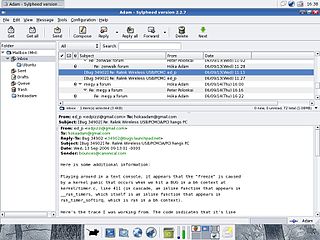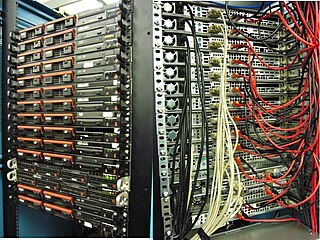Related Research Articles
Kermit is a computer file transfer and management protocol and a set of communications software tools primarily used in the early years of personal computing in the 1980s. It provides a consistent approach to file transfer, terminal emulation, script programming, and character set conversion across many different computer hardware and operating system platforms.

An operating system (OS) is system software that manages computer hardware and software resources, and provides common services for computer programs.

vi is a screen-oriented text editor originally created for the Unix operating system. The portable subset of the behavior of vi and programs based on it, and the ex editor language supported within these programs, is described by the Single Unix Specification and POSIX.
In computer networking, the Name/Finger protocol and the Finger user information protocol are simple network protocols for the exchange of human-oriented status and user information.

A man page is a form of software documentation usually found on a Unix or Unix-like operating system. Topics covered include computer programs, formal standards and conventions, and even abstract concepts. A user may invoke a man page by issuing the man command.
UUCP is a suite of computer programs and protocols allowing remote execution of commands and transfer of files, email and netnews between computers.

Sylpheed is an open-source e-mail client and news client licensed under GNU GPL-2.0-or-later with the library part LibSylph under GNU LGPL-2.1-or-later. It provides easy configuration and an abundance of features. It stores mail in the MH Message Handling System. Sylpheed runs on Unix-like systems such as Linux or BSD, and it is also usable on Windows. It uses GTK+.
Uptime is a measure of system reliability, expressed as the percentage of time a machine, typically a computer, has been working and available. Uptime is the opposite of downtime.
The printing subsystem of UNIX System V is one of several standardized systems for printing on Unix, and is typical of commercial System V-based Unix versions such as Solaris and SCO OpenServer. A system running this print architecture could traditionally be identified by the use of the user command lp as the primary interface to the print system, as opposed to the BSD lpr command.

Unix System V is one of the first commercial versions of the Unix operating system. It was originally developed by AT&T and first released in 1983. Four major versions of System V were released, numbered 1, 2, 3, and 4. System V Release 4 (SVR4) was commercially the most successful version, being the result of an effort, marketed as Unix System Unification, which solicited the collaboration of the major Unix vendors. It was the source of several common commercial Unix features. System V is sometimes abbreviated to SysV.

In some operating systems, including Unix-like systems, a pseudoterminal, pseudotty, or PTY is a pair of pseudo-device endpoints (files) which establish asynchronous, bidirectional communication (IPC) channel between two or more processes.

ClamAV (antivirus) is a free software, cross-platform antimalware toolkit able to detect many types of malware, including viruses. It was developed for Unix and has third party versions available for AIX, BSD, HP-UX, Linux, macOS, OpenVMS, OSF (Tru64), Solaris and Haiku. As of version 0.97.5, ClamAV builds and runs on Microsoft Windows. Both ClamAV and its updates are made available free of charge. One of its main uses is on mail servers as a server-side email virus scanner.
The MH Message Handling System is a free, open source e-mail client. It is different from almost all other mail reading systems in that, instead of a single program, it is made from several different programs which are designed to work from the command line provided by the shell on Unix-like operating systems. Another difference is that rather than storing multiple messages in a single file, messages each have their own separate file in a special directory. Taken together, these design choices mean that it is very easy and natural to script actions on mail messages using the normal shell scripting tools.

The file command is a standard program of Unix and Unix-like operating systems for recognizing the type of data contained in a computer file.

The history of Unix dates back to the mid-1960s, when the Massachusetts Institute of Technology, AT&T Bell Labs, and General Electric were jointly developing an experimental time-sharing operating system called Multics for the GE-645 mainframe. Multics introduced many innovations, but also had many problems. Bell Labs, frustrated by the size and complexity of Multics but not its aims, slowly pulled out of the project. Their last researchers to leave Multics – among them Ken Thompson, Dennis Ritchie, Doug McIlroy, and Joe Ossanna – decided to redo the work, but on a much smaller scale.

The Berkeley Software Distribution or Berkeley Standard Distribution (BSD) is a discontinued operating system based on Research Unix, developed and distributed by the Computer Systems Research Group (CSRG) at the University of California, Berkeley. The term "BSD" commonly refers to its open-source descendants, including FreeBSD, OpenBSD, NetBSD, and DragonFly BSD.

Unix is a family of multitasking, multi-user computer operating systems that derive from the original AT&T Unix, whose development started in 1969 at the Bell Labs research center by Ken Thompson, Dennis Ritchie, and others.

Super Dimension Fortress is a non-profit public access UNIX shell provider on the Internet. It has been in continual operation since 1987 as a non-profit social club. The name is derived from the Japanese anime series Super Dimension Fortress Macross; the original SDF server was a Bulletin board system created by Ted Uhlemann for fellow Japanese anime fans. From its BBS roots, which have been well documented as part of the BBS: The Documentary project, SDF has grown into a feature-rich provider serving members around the world.
The History of the Berkeley Software Distribution begins in the 1970s.
References
- ↑ da Cruz, Frank; Gianone, Christine. "THE DECSYSTEM-20 AT COLUMBIA UNIVERSITY (1977-1988)". Columbia University, New York City. Retrieved 2008-07-09.
- ↑ ftp://columbia.edu/pub/mm/README.TXT